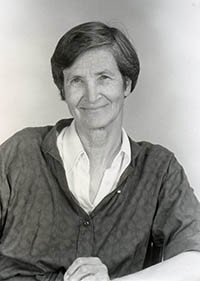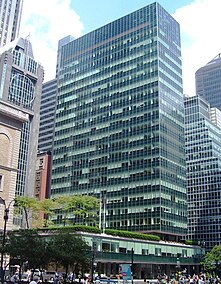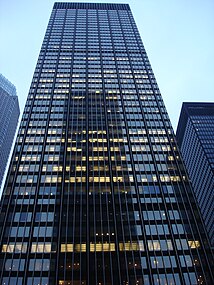Natalie de Blois
Natalie de Blois | |
|---|---|
 | |
| Born | April 2, 1921 |
| Died | July 22, 2013 (aged 92) |
| Nationality | American |
| Alma mater | Columbia University |
| Occupation | Architect |
| Practice | Skidmore, Owings & Merrill |
| Buildings | Union Carbide Building, Lever House, Pepsi Cola Headquarters, Connecticut General Life Insurance Company Headquarters |
Natalie Griffin de Blois (April 2, 1921 – July 22, 2013) was an American architect. She began her architectural career in 1944 and became known as a pioneer in the male-dominated world of architecture. She was a partner for many years in the firm of Skidmore, Owings and Merrill"[1] Her notable works include Pepsi building, Lever House, and the Union Carbide Building in New York City, the Equitable Building in Chicago, the low-rise portions of the Ford World Headquarters in Dearborn, Michigan, and the Connecticut General Life Insurance Company Headquarters in Bloomfield, Connecticut. Several of de Blois' buildings are included in the tallest woman-designed buildings in the world. She later taught architecture at the University of Texas in the 1980s and 1990s.[2]
Early years
De Blois was born in Paterson, New Jersey, into a family of three generations of engineers.[3] She was interested in architecture from an early age, saying in 2004, "I was selected to be the one that would go into art. I told my father that I wanted to be an architect from the age of ten or twelve."[4] She attended the Western College for Women in Oxford, Ohio, and received an architecture degree from Columbia University in 1944.[5][6] While at Columbia, she worked at Babcock & Wilcox during the summer and for Frederick John Kiesler.[7]
Architectural career
De Blois began her career at a New York firm, Ketchum, Gina, and Sharpe,[5] but was fired after "rebuff[ing] the affections" of one of the firm's male architects, who asked for her to be fired.[8] She then joined the architectural firm Skidmore, Owings and Merrill (SOM).[9] While working at SOM, De Blois became known as a "pioneer" as a female architect in the "male-dominated world of architecture."[8] She designed a number of major business buildings on Park Avenue in New York City, including the Pepsi building and the Union Carbide Building (now known as the Chase Building).[1] She worked with Gordon Bunshaft on the Pepsi building, which was completed in 1960 and was "praised by critics for its gem-like, seemingly levitating exterior walls of gray-green glass and aluminum."[6]
She transferred to the Chicago branch of SOM in 1962, continuing to work on skyscrapers in Chicago until 1974.[9] While there, she founded the Chicago Women in Architecture.[9] Richard Tomlinson, the managing partner of SOM's Chicago office, believes it's the "best thing that ever happened to us", and De Blois was eventually promoted to associate partner in 1964.[2] Her works in Chicago include the Equitable Building.
De Blois joined Neuhaus & Taylor (now known as 3-D International) in Houston in 1974.[9] In 1980, she began teaching at the University of Texas School of Architecture, and was a faculty member until 1993.[9] She died at age 92 in Chicago.
In 2014, De Blois was recognized for her work designing the Pepsi Cola World Headquarters and Union Carbide Building, winning sites of Built by Women New York City,[10] a competition launched by the Beverly Willis Architecture Foundation during the fall of 2014 to identify outstanding and diverse sites and spaces designed, engineered and built by women. Willis is quoted as saying "There wasn't anybody in the country quite like Natalie, because there was no one else working for a firm quite like Skidmore."[1]
Notable projects
- Union Carbide Building (now known as the Chase Building), 270 Park Avenue, New York - Completed 1960, de Blois Senior Designer[9]
- New York State Building, 5 East 57th Street, New York - Designer of 1946 renovation
- Terrace Plaza Hotel, Cincinnati, Ohio - 1948, Design Coordinator
- Lever House, New York - 1952, Design Coordinator
- Pepsi Cola Headquarters, 500 Park Avenue, New York - Senior Designer
- Emhart Manufacturing Company Building - 1962, Senior Designer
- Connecticut General Life Insurance Company Headquarters, Bloomfield, Connecticut - 1957, Senior Designer
- Equitable Building, Chicago[8]
Gallery
-
Lever House
New York, New York 1952 -
Union Carbide Building (now 270 Park Avenue)
New York, New York 1954 -
Connecticut General Life Insurance Headquarters
Bloomfield, CT 1957 -
Pepsi Cola Headquarters
New York, New York 1959 -
Equitable Building
Chicago, Illinois 1965 -
270 Park Avenue
New York, New York 1960
Awards
- Fulbright fellowship to study at the Ecole des Beaux-Arts
- Edward J. Romieniec Award, recognizing an outstanding architectural educator, by the Texas Society of Architects
- Named honoree of the Natalie de Blois scholarship, UT Austin
- Fellow of the AIA (1974)
Further research
- Oral history of Natalie de Blois. Interview by Betty J. Blum, Chicago Architects Oral History Project, Ernest R. Graham Study Center for Architectural Drawings, Department of Architecture, the Art Institute of Chicago.
- Susana Torre, Women in American Architecture: A Historic and Contemporary Perspective
- Natalie de Blois papers, University of Texas Architecture School
- AIA Historical Directory of American Architects
Notes
- ^ a b c Dunlap, David W. (31 July 2013). "An Architect Whose Work Stood Out, Even if She Did Not". Retrieved 28 February 2018 – via NYTimes.com.
- ^ a b Kamin, Blair (July 2013). "NATALIE DE BLOIS 1921-2013: Key architect at Skidmore, Owings & Merrill". Chicago Tribune.
- ^ Blum, Betty J (September 2004). "Natalie de Blois and the Connecticut General LIfe Insurance Building" (PDF). Docomomo Journal. Archived from the original (PDF) on 8 April 2015. Retrieved 9 October 2013.
- ^ Mertens, Detlef (17 June 2004). "Natalie de Blois Interviewed by Detlef Mertins". Skidmore, Owings & Merrill. Archived from the original on 1 September 2013. Retrieved 9 October 2013.
- ^ a b "Natalie Griffin de Blois", Beverly Willis Architecture Foundation (last visited July 31, 2013).
- ^ a b Blair Kamin (August 1, 2013). "Natalie de Blois dies at 92; pioneering female architect". Los Angeles Times.
- ^ Mertins, Detlef (2006). "Cracking the Glass Ceiling A look back at the career of trailblazing architect Natalie de Blois". SOM JOURNAL. No. 4. Retrieved 3 April 2015.
- ^ a b c Obituary, Chicago Tribune, July 30, 2013.
- ^ a b c d e f "Union Carbide Building" Archived 2014-08-11 at the Wayback Machine, Beverly Willis Architecture Foundation (last visited July 31, 2013).
- ^ "Beverly Willis Architecture Foundation Hosts Leadership Awards Gala, Kicks off Built By Women Exhibition". Architectural Record. Retrieved March 8, 2015.






